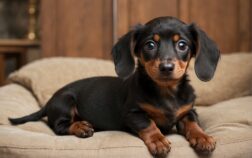Last Updated on December 1, 2021 by Marco
Figuring out how to introduce new dog food quickly and smoothly is a problem many dog owners don’t realize they may someday need to tackle. After all, dogs are enthusiastic eaters, right?
Most of them are true. However, some dogs can be somewhat obstinate when it comes to diet changes. In those cases, you may need to resort to some tricks and gimmicks to get your dog to eat its new food. Here’s our quick guide on how to go about it.
When and How To Introduce New Dog Food To Your Pet?
Changing dog food is usually an easy and issue-free process. There are lots of reasons to do it too as well as several different ways to go about it.
When Is The Right Time For Changing Dog Food?
There are several especially common reasons to try and switch your dog’s food. Most are pretty standard, expected, and inconsequential. Some, however, can be necessitated because of a health problem or a behavioral issue. So, let’s first go over the possible reasons for switching to new dog food.
- Your young pup is becoming an adult and needs dog food corresponding to its age
- Your dog is becoming a senior and needs a diet change once again
- The dog is developing a certain health issue such as kidney disease, diabetes, gastrointestinal problems, or something else
- You want to switch to higher-quality dog food
- You’re considering diversifying your dog’s diet
- Your pet is becoming overweight and you want to reign the weight gain in
- You’re trying to prevent/deal with your dog’s dental issues with a specialized oral health dog food
- You need to switch to a more affordable type of food (hopefully, without compromising the food’s quality)
Learn more about: Changing Dog Food Within The Same Brand – The Why, When, And How
All of those is perfectly valid reason to change your dog’s diet. As you can see, most of them are pretty issue-free too and are just something dog owners need to do from time to time.
Switching Dog Food To The Same Or To A Different Brand?
It doesn’t really matter as long as the quality of the food is still good. Besides, dog foods vary greatly even within the same brands. So, whether you switch to a different brand or not, the more important question is what are the ingredients of the new food. Are they something your dog will like? Something the dog has never eaten before? And, crucially, is the dog allergic to any of the new ingredients? Ideally, you should consult with your vet about that last question ahead of time.
Is Switching Dog Food A Time-consuming Process?
Not necessarily but it could be. Most dogs are pretty ravenous eaters and will happily binge anything you put in their bowl. Some, however, can be somewhat cat-like and refuse to try their new food after even just a single sniff.
In those situations, you can always just try several new types of food that all match your preferred criteria – chances are that your dog will accept at least one of them.
Even then, however, there are some extra stubborn dogs that will continue to refuse any new dog food that isn’t their chosen favorite. In those situations, you may need to employ some trickery. That, depending on just how obstinate your dog is, can take about a couple of weeks or even more. Still, with enough patience and persistence, your dog should accept any new food as long as it’s good enough.
How To Transition In The Smoothest Possible Way?
If your dog is 100% adamant about not liking any new food you offer, you will need to resort to some deception. The first and most intuitive method you can try is to sprinkle your dog’s new food with some delicious food he or she likes.
Is your pooch a fan of fish sauce, for example? Adding a spoonful on top of the new food can quickly change your dog’s mind. Alternatively, you can mix a few dry treats inside or your dog’s favorite kibble in the new food.
If neither of these methods works, you will need to buckle up and prepare for the slow switch. This method involves mixing your dog’s new and old food in a ratio that will be acceptable for your dog.
You can try a 75% old and 25% new food ratio for starters, for example. If your dog refuses even that, try 80/20 or even 90/10 – whatever gets your dog to finally surrender and start eating. Then, just keep giving your dog that ration for a couple of days. Then, slowly start increasing the amount of new food in the mixture.
After about a week you should be at a 50/50 ratio between old and new food. A week more and should be past the 25/75 line. From there, it’s likely a day or more until switching to 100% new food.
Potential Health Problems
Knowing how to introduce new dog food is one thing but you should also be aware of some possible health concerns. Some dogs can indeed experience diarrhea, vomiting, or stomach upset, or gas when you switch their food a bit too quickly.
Alternatively, it can be because their new food just doesn’t agree with them. Food allergies are a big thing to watch out for here, such as wheat & grain allergies or allergies toward certain meats. Naturally, if you see such a reaction, you should always consult with your vet before you do anything.
How To Introduce New Food To A “Free Feeding” Dog?
Free feeding is a term for dogs that are allowed to eat as much as they want during any time of the day. This is typically done by just pouring a huge ball of kibble for your dog and leaving it there throughout the whole day.
Free feeding is often done with cats but is generally ill-advised for dogs. That’s because they are even more ravenous than most felines and can easily get overweight. In fact, free-feeding is even ill-advised for cats.
If you are about to switch the food of a free-feeding dog, this is a good time to also stop free-feeding altogether and just move to a specific feeding schedule. The hours-long pauses between the meals will only incentivize your dog, even more, to eat its new food anyway. Then, after your dog has eaten, remove the bowl even if there’s still some food in it.
Jordan is an animal–lover who specializes in dachshunds. He has owned and cared for dachshunds since he was a child, and his passion for these unique dogs has only grown with time. Jordan is an avid researcher and learner, and spends a large portion of his free time studying the history, behaviour, and health of dachshunds. He has a knack for training and socializing his own dogs, and loves introducing them to new experiences. When not caring for his own pets, Jordan likes to volunteer at local animal rescue shelters, helping to find homes for abandoned dachshunds. He is a true animal advocate, and dedicates his time to ensure that all animals receive the love, respect, and care they deserve.





